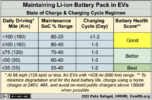The number of charging sessions for an EV's battery pack, regardless of your SoC and routine charging limit, have affect on battery life. Can we discuss this issue in light of Tesla recommendations to Plug in to a TWC every night?
Why to avoid high powered DC chargers for your routine charging needs, if you have a choice or not on a long road trip?
What are your thoughts about the recommendations below?
Why to avoid high powered DC chargers for your routine charging needs, if you have a choice or not on a long road trip?
What are your thoughts about the recommendations below?



